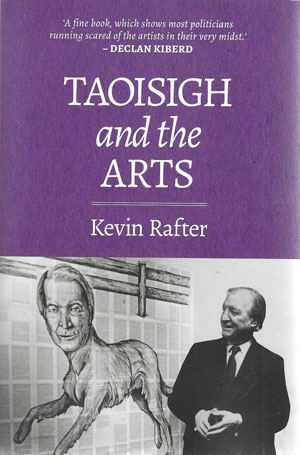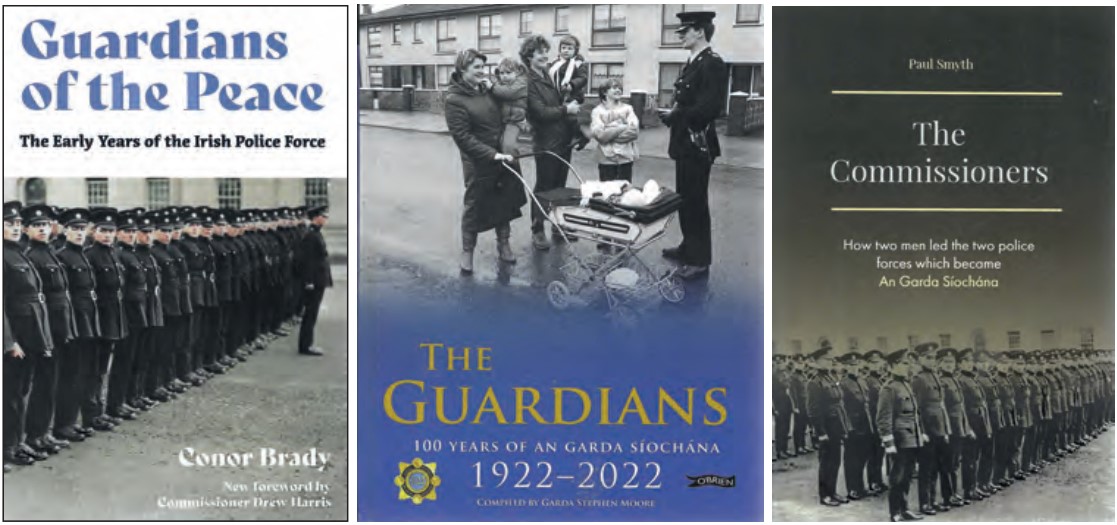BOOKWORM
Published in Book Reviews, Book Reviews, Issue 6 (November/December 2022), Volume 30By Joe Culley
@TheRealCulls
The man who ruthlessly cross-examined Patrick Kavanagh in his failed 1954 libel action against The Leader newspaper is the same man who established the Arts Council: John A. Costello. In Taoisigh and the arts, journalist, DCU lecturer and current chairman of the council Kevin Rafter offers a thoroughly entertaining and enlightening survey of the relationship that our political leaders have had with the arts.
In a remarkably seamless stream of enjoyable anecdote, Rafter examines how the personal biases of the heads of government have been reflected in their attitude, in particular, to state funding for the arts. Of course, in general it is not a positive story. Even Charlie Haughey, who made such play of being imbued with an artistic sensibility and whom many might still believe left a strong legacy in the field, in reality rarely produced effective policy. Lots of promises, and lots of portraits of himself, but little support for the artists themselves. It’s a terrific read.
As you know, this has been the centenary of the foundation of An Garda Síochána, and we might have expected a new, proper history of the force to be produced. Instead, we have the—surprisingly welcome—reissue of Conor Brady’s Guardians of the Peace: the early years of the Irish police force. Remarkably, this was first published in 1974—that, kids, is 48 years ago. A lot has happened in the half-century since.
Brady, in a new introduction, is quick to make that point. The former editor of the Irish Times and former member of the Garda Síochána Ombudsman Commission says that the force was slow to adapt to a rapidly changing society, and he mentions the ‘Kerry babies’ case, the carry-on in Donegal in the 1990s and the revelations of Maurice McCabe as examples of its failings. One could add the emergence of the ‘heavy gang’ in the late 1970s. He also pays tribute to the more recent studies of the force.
Nevertheless, Guardians is still a good read, and Brady’s retelling of the efforts in 1921–2, amid the general chaos, to create a new ‘Civic Guard’, including a defining mutiny in the Kildare barracks, remains engaging.
The force itself has produced a commemorative publication, The Guardians: 100 years of An Garda Síochána 1922–2022. Compiled by Garda Stephen Moore, it is a collection of essays by serving and retired gardaí about life in the force. All the essays are perfectly fine and worthy, and some are entertaining, but it is telling that Moore, in a brief piece on the establishment of the force, quotes from Brady’s book.
Finally, retired garda Paul Smyth emphasises ‘the two shades of green’ represented by the early leaders of the force in The Commissioners: how two men led the two police forces which became An Garda Síochána. Of the two, Michael Staines is probably better known owing to his significant involvement with the Irish Volunteers and the Easter Rising. William (W.R.E.) Murphy instead took the Redmondite road and served with great distinction throughout the First World War.
The book focuses on the men’s backgrounds rather than on their duties and accomplishments as commissioner, but the section on Murphy does include a quite brief but revealing explanation of where the funds came from for the establishment of the Garda boat club.
Speaking of policing, in November 1952 the body of a nineteen-year-old woman was found in a small wood just off the lane that led to her nearby home in the village of Whiteabbey, on the shores of Belfast Lough, just north of the city. According to her autopsy, Patricia Curran had suffered a blow to the head and then been stabbed 37 times. So far, so gruesome. Patricia, however, was no ordinary young woman; she was the daughter of a judge, and the scandal meant that the authorities were under pressure to ‘get their man’. Within days they had their suspect, a young Scot serving with the RAF in the area.
In Who killed Patricia Curran? Kieran Fagan reopens the case to discover How a judge, two clergymen and various policemen conspired to frame a vulnerable man. Fagan, a writer, journalist and trade unionist with a long association with the Irish Times, brings us a comprehensive investigation into the people involved, which touches on class, politics, religion and even sexual orientation. Obviously, the young RAF man, Iain Hay Gordon, had been set up. So, who did kill Patricia? You’ll have to read Fagan’s entertaining account to find out.
Earlier this year we were raving about Terence Dooley’s Burning the Big House (Bookworm, HI 30.4, July/August 2022). Well, the Maynooth professor is back as co-editor, with Christopher Ridgway, of Country house collections: their lives and afterlives, a gorgeously produced hardback from Four Courts Press. It comprises fourteen essays, derived from presentations at the seventeenth Historic Houses Conference in 2019, which ‘look at how and why collections were amassed, examine their break-ups, and the reasons for such dispersals, whether elective or enforced; … they consider the afterlives of objects as they moved into the art market, the museum world or elsewhere; … and they deliberate on how objects are viewed and understood in new locations by different audiences’.
This might sound rather dry, but the contributions are full of fascinating detail and insights into the lives of the people who, first, built the collections and were then forced, or chose, to begin to break them up. Not surprisingly, Dooley’s piece on Carton House and the FitzGerald family stands out. Robert O’Byrne tells the story of the Bagwell library at Marlfield, outside Clonmel, while Judith Hill reports on ‘Transforming Farmleigh: from private residence to national treasure’. Collections in Britain, the US and even Lithuania are also addressed.
Patricia O’Reilly’s Orpen at war is an unusual creature, an ‘illustrated biographical novel’. It is, in fact, a handsomely produced paperback full of reproductions of the artist’s work associated with his time serving as an official artist for the British army at the front. The Irish artist initially struggled with his superiors, who were really only interested in the production of lovely propaganda whereas he wanted to portray the daily life of the Tommies. Orpen eventually won out, and in a burst of energy produced dozens of now-familiar sketches and paintings of death in the trenches, intimate moments of reflection or of the ‘thousand-yard stare’ in field hospitals.
Orpen was then commissioned to cover the peace conference in Paris, where he met his muse and lover, a young volunteer Red Cross worker from Lille named Yvonne Aubicq. Their relationship blossoms in Murphy’s fictional retelling.
One little quirk in relation to Robert Collins’s Noraid and the Northern Ireland Troubles 1970–1994 is that the word ‘Noraid’ rarely appears in the text; the body was formally titled Irish Northern Aid (set up in 1970 to support the families of prisoners) and is referred to throughout as INA. Collins lectures at the University of Limerick, and this study grew out of his Ph.D research. He writes that this is ‘the first serious examination of INA and, in particular, how the organisation capitalised on major events in Ireland to raise millions of dollars and advertise the motives of the Republican Movement in Ireland to an American audience’. Among Collins’s sources are interviews with the major players, including Martin Galvin, editor of the Irish People newspaper.
‘Come on the Dubs!’: a brief history of the Royal Dublin Fusiliers is a small booklet commemorating the centenary of the disbandment of the regiment in 1922. For more information on the Royal Dublin Fusiliers Association—for example, you might be interested in their visits to historical overseas sites—write to oldpound1@gmail.com.
Kevin Rafter, Taoisigh and the arts (Martello Publishing, €12.95 pb, 209pp, ISBN 9781999896881).
Conor Brady, Guardians of the Peace: the early years of the Irish police force (New Island Books, €19.95, 235pp, ISBN 9781848408418).
Stephen Moore, The Guardians: 100 years of An Garda Síochána 1922–2022 (O’Brien Press, €29.99 hb, 304pp, ISBN 9781788493390).
Paul Smyth, The Commissioners: how two men led the two police forces which became An Garda Síochána (Carrowmore, €18 pb, 145pp, ISBN 9781739940119).
Kieran Fagan, Who killed Patricia Curran? How a judge, two clergymen and various policemen conspired to frame a vulnerable man (Kieran Fagan, £13 pb, 225pp, ISBN 9781739671907).
Terence Dooley and Christopher Ridgway (eds), Country house collections: their lives and afterlives (Four Courts Press, €45 hb, 336pp, ISBN 9781846829758).
Patricia O’Reilly, Orpen at war (The Liffey Press, €22.95 pb, 288pp, ISBN 9781739789237).
Robert Collins, Noraid and the Northern Ireland Troubles 1970–1994 (Four Courts Press, €45 hb, 224pp, ISBN 9781801510189).
‘Come on the Dubs!’: a brief history of the Royal Dublin Fusiliers (RDF Association, n/a, 50pp, ISBN 9780993198984).



















